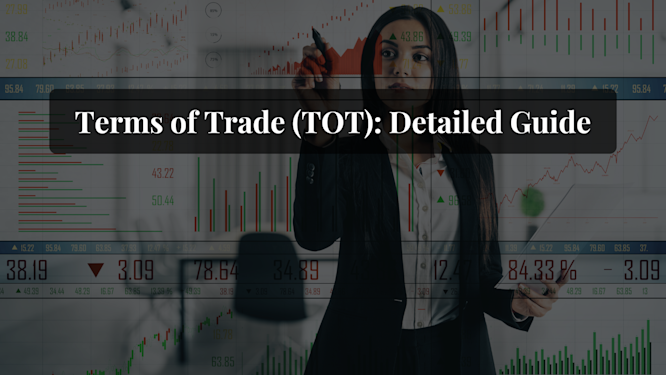TOT Full Form (Terms of Trade): Definition, Usage, and Influential Factors
Other
What Are Terms of Trade (TOT)? - TOT full form
The Terms of Trade (TOT) represent a crucial economic indicator that measures the relationship between the prices a country earns for its exports and the prices it pays for its imports. In simple terms, it reflects the value of a country’s exports relative to its imports. TOT is calculated as the ratio of export prices to import prices, multiplied by 100. This calculation provides a percentage figure that helps assess a country’s economic position in the global market.
When a country’s TOT is less than 100%, it signifies that the nation spends more on imports than it earns from exports, indicating a negative trade balance. On the other hand, a TOT value greater than 100% demonstrates a surplus, meaning the country generates more revenue from exports than it spends on imports. For instance, in the United States, fluctuations in trade activity are closely monitored through the Import/Export Price Index (MXP), a comprehensive measure of changes in trade values over time.
Key Highlights:
TOT is a significant economic metric that provides insight into a country’s trade performance and overall economic health.
It is expressed as a ratio that reflects how many units of exports are needed to purchase one unit of imports.
The formula for calculating TOT is:
A TOT exceeding 100% or showing consistent improvement over time can be viewed as a positive sign, often indicating rising export prices relative to steady or declining import prices.
Understanding Terms of Trade (TOT) - TOT full form
TOT serves as a vital barometer of a country’s economic health. It provides valuable insights into trade patterns and helps policymakers, economists, and businesses assess the efficiency and profitability of international trade. However, it is crucial to understand the factors driving changes in TOT to draw accurate conclusions. Changes in export and import prices significantly influence TOT, and these variations can arise from numerous economic, political, and market-related factors.
To facilitate analysis, TOT is frequently represented as an index that tracks changes over time. A rising TOT generally signals favorable economic conditions, as it often reflects increasing export prices, declining import prices, or a combination of both. Conversely, a declining TOT indicates that import prices are rising faster than export prices, or that export prices are falling more rapidly than import prices. These trends can have profound implications for a country’s trade balance, foreign exchange reserves, and overall economic stability.
Factors Influencing Terms of Trade
Several factors influence a country’s TOT, ranging from global economic trends to domestic policies. Key factors include:
Exchange Rates: Exchange rate fluctuations play a significant role in shaping TOT. A strong domestic currency can make imports cheaper and improve TOT, while a weak currency has the opposite effect.
Inflation: Inflation rates in exporting and importing countries can affect the relative prices of goods and services, influencing TOT. Higher inflation in export markets can raise export prices, potentially improving TOT.
Global Commodity Prices: For countries heavily reliant on commodity exports, changes in global commodity prices can significantly impact TOT. For example, a rise in oil prices benefits oil-exporting nations but adversely affects oil-importing countries.
Trade Policies: Tariffs, trade agreements, and other policies designed to protect domestic industries can alter TOT by affecting the prices of exports and imports.
Technological Advancements: Innovations that reduce production costs can make exports more competitive, potentially improving TOT.
Market Demand: Shifts in global demand for specific goods and services can influence export prices, thereby impacting TOT.
Fluctuating Terms of Trade - TOT full form
The dynamic nature of TOT means that it often fluctuates due to changing economic conditions. A country experiences improved TOT when it can purchase more imported goods for every unit of exports sold. Such an improvement is generally seen as beneficial, as it allows the country to allocate fewer resources to secure the same amount of imports. Improved TOT can also help curb domestic cost-push inflation, as falling import prices reduce input costs for local industries.
However, there are potential downsides to improved TOT. For instance, higher export prices can reduce demand in international markets, leading to a decline in export volumes. This situation may negatively affect the country’s balance of payments (BOP), offsetting the benefits of improved TOT.
On the other hand, a deteriorating TOT means that a country must export more to afford the same volume of imports. This can strain resources and negatively impact economic growth. According to the Prebisch-Singer hypothesis, many developing nations experience declining TOT due to falling commodity prices relative to manufactured goods. This trend underscores the importance of diversifying export portfolios to mitigate the risks associated with volatile commodity markets.
Example of TOT
A notable example of TOT dynamics occurred during the early 2000s commodity price boom. During this period, developing countries, particularly those reliant on commodities like oil and copper, experienced significant improvements in their TOT. These nations could purchase more consumer goods and capital equipment from other countries in exchange for the same volume of commodity exports.
However, the rise of globalization and advancements in manufacturing technologies have since driven down the prices of manufactured goods. This trend has reduced the comparative advantage of industrialized countries while narrowing the TOT gap between developed and developing nations.
How to Calculate Terms of Trade - TOT full form
The formula for calculating TOT is straightforward:
For example, if the export price index is 120 and the import price index is 100, the TOT would be:
This result indicates that export prices are 20% higher than import prices, reflecting a favorable trade position.
What Does a Rising TOT Indicate? - TOT full form
An increasing TOT ratio is often seen as a positive economic signal. It indicates that a country’s exports are becoming more valuable relative to its imports. Over time, this can lead to a trade surplus, where export revenues exceed import expenditures. A rising TOT also suggests improved purchasing power, as the country can secure more imports for each unit of exports.
However, it is essential to examine the underlying causes of a rising TOT. For instance, a TOT increase driven by falling import prices is generally more sustainable than one resulting from inflated export prices, which may reduce competitiveness in global markets.
Strategies to Improve TOT
Countries can adopt various strategies to improve their TOT and strengthen their economic position. These include:
Currency Appreciation: A stronger domestic currency reduces the cost of imports and boosts export revenues, improving TOT. However, this strategy must be balanced to avoid making exports too expensive in global markets.
Diversifying Exports: Expanding the range of exported goods and services can reduce reliance on volatile commodities and improve TOT stability.
Enhancing Competitiveness: Investments in technology, infrastructure, and workforce development can make exports more competitive, driving higher export prices and improving TOT.
Trade Agreements: Negotiating favorable trade agreements can reduce tariffs and other barriers, enhancing export opportunities and improving TOT.
Controlling Inflation: Maintaining stable inflation rates can prevent export prices from rising too quickly, ensuring sustained demand in global markets.
Terms of Trade (TOT) is a vital economic metric that reflects a country’s trade performance and overall economic health. By examining the ratio of export prices to import prices, TOT provides insights into a nation’s purchasing power, trade balance, and economic competitiveness. While a rising TOT is generally considered favorable, it is crucial to analyze the underlying factors driving changes in export and import prices to understand their long-term implications.
As global trade dynamics continue to evolve, countries must adopt proactive strategies to improve their TOT. By leveraging currency policies, diversifying exports, enhancing competitiveness, and pursuing trade agreements, nations can strengthen their economic positions and achieve sustainable growth in an increasingly interconnected world.



